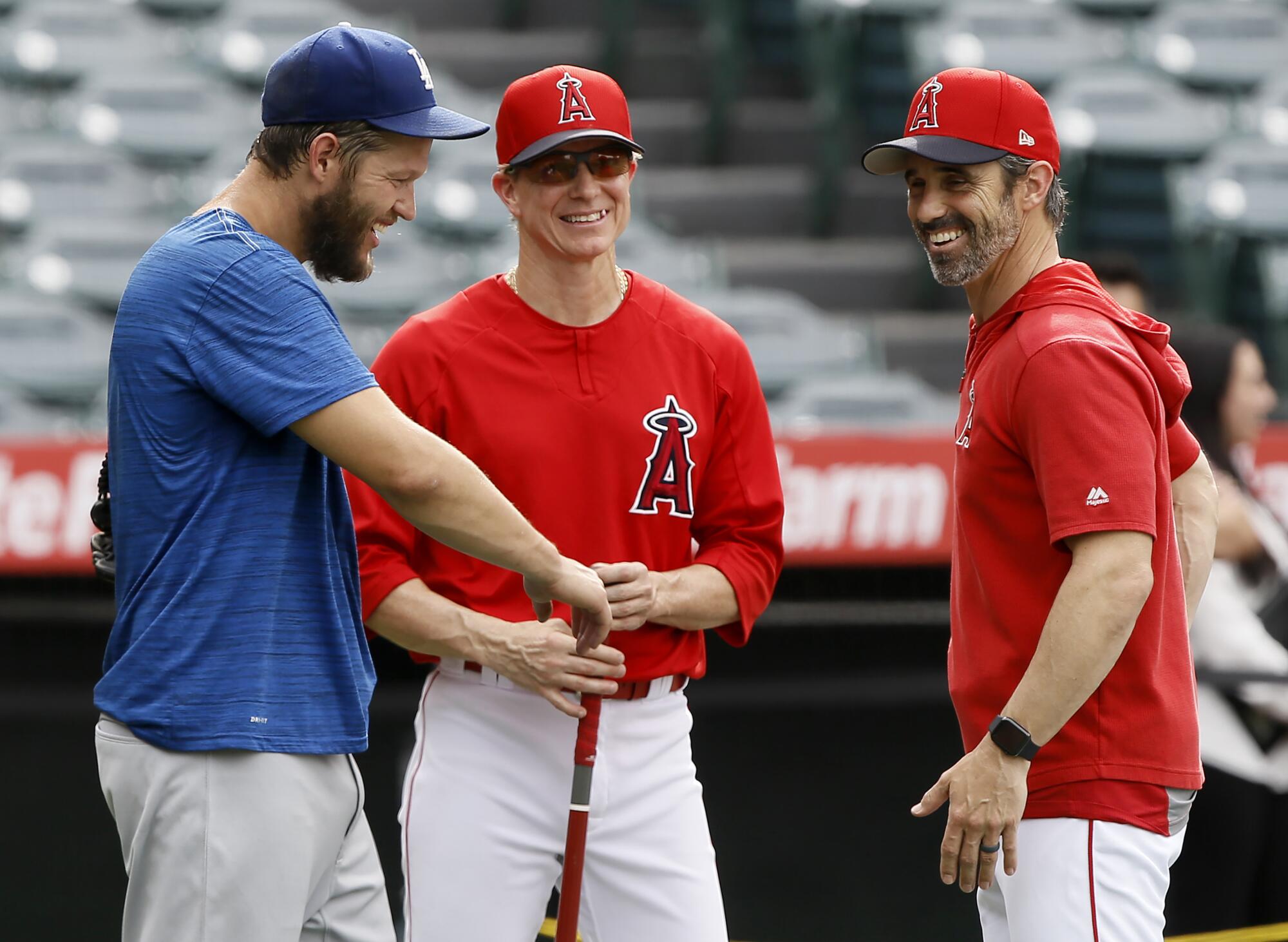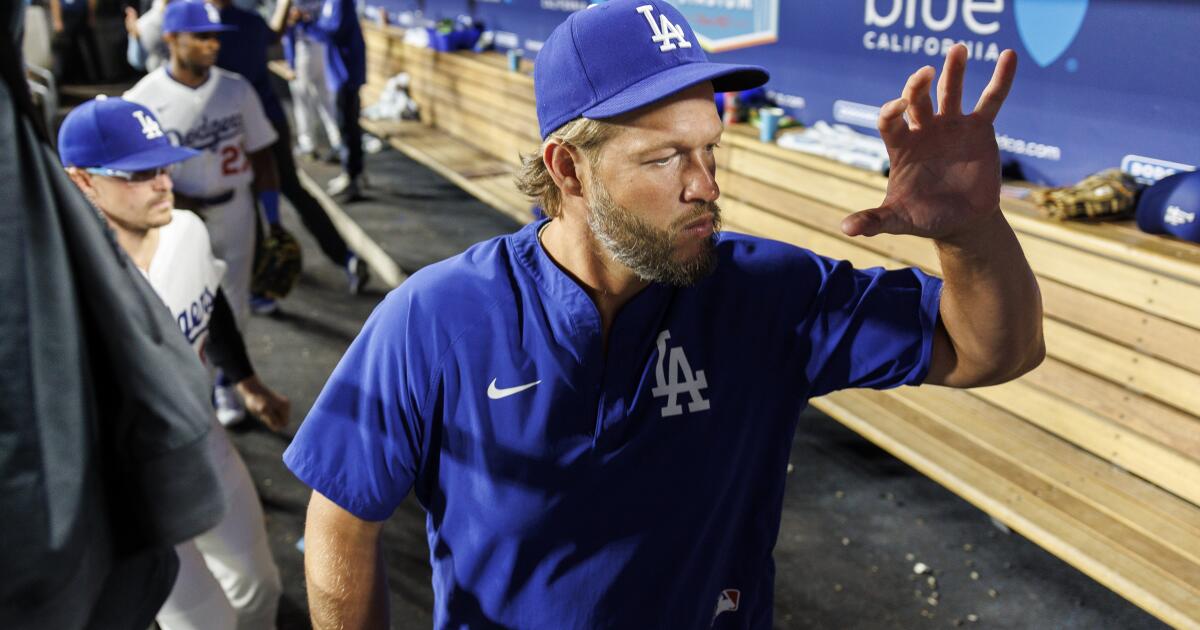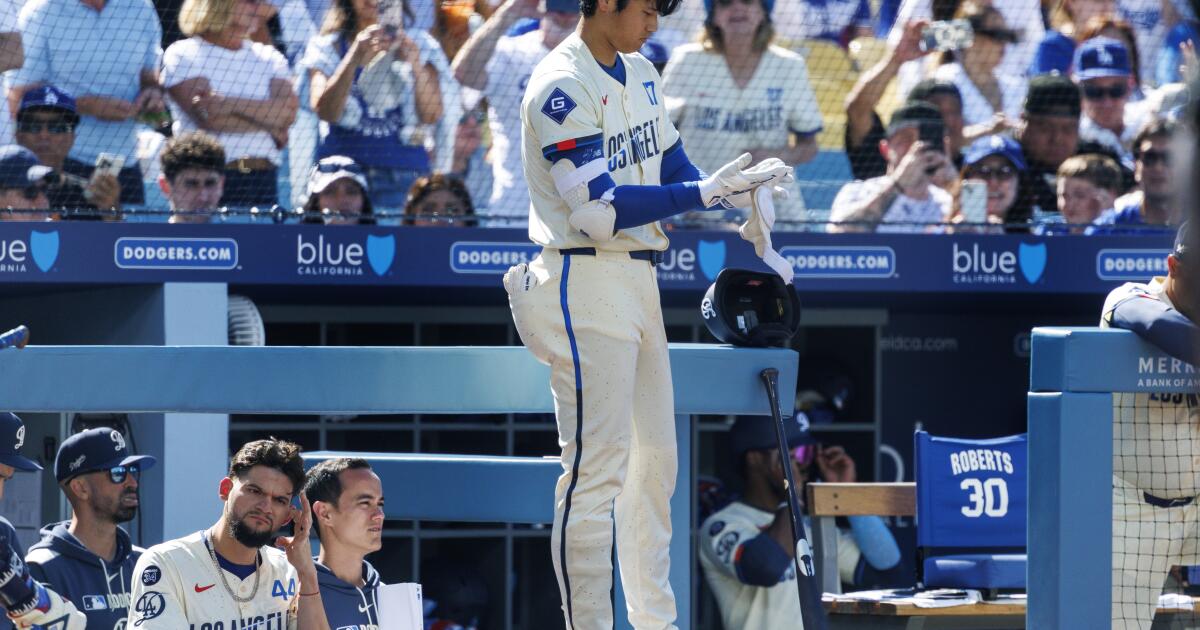How a three-pitch mix has Clayton Kershaw on cusp of 3,000 strikeouts

The transformation happened quickly in May 2009.
Early into his second year in the majors, a young Clayton Kershaw was enduring a sophomore slump with the Dodgers. Looking for a way to complement his predominantly fastball/curveball mix, he began toying around with a slider in his between-starts bullpen sessions.
When Brad Ausmus, the well-traveled 40-year-old backup catcher on that year’s Dodgers team, heard about the experiment, he didn’t initially think much of it. That a raw 21-year-old talent would be tinkering with a new pitch didn’t come as much of a surprise.
But when Ausmus asked the club’s bullpen catcher, Mike Borzello, how Kershaw’s new pitch looked, he got his first inkling it might be special.
“He was like, ‘It’s really good,’” Ausmus recalled recently. “I said, ‘Oh, so maybe he’ll throw it in a couple more bullpens before taking it into the game.’ And he’s like, ‘Ehh, I think he might take it into the game his next start.’”
A few weeks later, Ausmus got his first chance to see it up close, calling it sporadically in a Freeway Series game at Angel Stadium. That day, Kershaw spun a gem, throwing seven scoreless innings in a Dodgers victory.
But it was afterward, as Kershaw, Ausmus and longtime Dodgers pitching coach Rick Honeycutt reviewed the outing, that the longtime catcher started to understand that Kershaw wasn’t just any young pitcher. That his tantalizing talent was matched by a preternatural aptitude. That his precocious battery mate was both a physical force and pitching prodigy.

Dodgers pitcher Clayton Kershaw, left, talks with former teammate Brad Ausmus, right, and coach Matt Martin before a game in 2019, when Ausmus was the manager of the Angels.
(Alex Gallardo/AP)
“Keep in mind, this is a rookie, basically, talking to a guy who’s been in the big leagues 17, 18 years,” Ausmus said. “And he goes, ‘Brad, I wish you would call more sliders.’”
Initially surprised, Ausmus thought to himself: “Really? This is a brand new pitch. We probably threw 10 or 15 of them.”
But Kershaw could already see the bigger picture. He immediately sensed how the new pitch might profoundly influence his game.
“If you think about it, the fastball was 95, the curveball was probably in the low-to-mid 80s, so there was a lot of separation in terms of velocity. It almost gave the hitter time to reload before swinging,” Ausmus said. “The slider did not allow the hitters to do that.”
Seventeen years, three Cy Young Awards, two World Series titles, and — very nearly — 3,000 strikeouts later, the rest has been singularly impressive history.
“It speaks to not only his knowledge, but his ability and his confidence,” said Ausmus, now bench coach for the New York Yankees. “He has an aptitude for the game. He adjusts. And he continues to perform at a high level. It really is remarkable … I miss having that guy as a teammate.”
When Clayton Kershaw takes the mound on Wednesday night at Dodger Stadium, he will need just three strikeouts to become the 20th member of Major League Baseball’s 3,000 strikeout club.
And, just as it was almost two decades ago, it will be the same primary three-pitch mix that is all but certain to lift him into such rarified air.
For better or (very rarely) worse, at full strength or in ailing health, the now 37-year-old future Hall of Famer has managed to perfect one of the sport’s all-time signature plans of attack on the mound:
Establish the fastball on the edge of the plate for a strike. Tunnel the slider on the same trajectory to get awkward swings when it tails off late. Mix in a curveball when a change of pace is needed. And never be afraid to change the sequence and tendencies of that infallible trio of pitches, using instinct and feel to amplify his physical talent.
“It’s what’s upstairs [that makes him special],” current Dodgers pitching coach Mark Prior said. “He’s always a step ahead.”
Countless big-league pitchers have used a similar fastball-slider-curveball repertoire. Even in Kershaw’s prime years, there were always others who could throw harder, or produce more break, or manipulate the ball with more gravity-defying spin.
What separates Kershaw are more foundational skills. His unwavering execution, in seasons he threw 200-plus innings or those in which he battled increasingly persistent injuries to his back, shoulder and even a bothersome left big toe. His unflappable persistence to move from one pitch, one start, one year to the next; never satisfied with his best moments nor shaken by his rare failures.
“He just knows the ins and outs of baseball, and has such good feel,” longtime teammate and backstop Austin Barnes said. “He’s like a train that comes at you consistently.”
That’s why, when Kershaw does inevitably cross the 3,000-strikeout threshold, it will be equal parts a testament to his talent and durability — an accomplishment that required him to continually reinvent his game without ever changing his fundamental nature as a pitcher.
“Clayton has everything the right way, on the field, off the field, over a long period of time,” manager Dave Roberts said last week.
“It’s hard to wrap your head around what it takes,” he added, “as far as longevity, and greatness.”

“He’s like a train that comes at you consistently,” former Dodgers catcher Austin Barnes, center, said of pitcher Clayton Kershaw, left.
(Robert Gauthier / Los Angeles Times)
Few players have produced the kind of prolonged period of greatness Kershaw did during the peak of his career. Starting in that 2009 season, he went on a run of sub-3.00 ERA campaigns in 11 of his next 12 years. In seven of them, he had 200 or more strikeouts, including a career-high 301 punchouts in 2015. Eight of his 10 All-Star selections came in that stretch, as did his three Cy Young Awards and a 2014 National League MVP (still the last time a pitcher won the game’s highest individual honor).
His only blemishes in that time were repeated disappointments in the playoffs. But even in most of those, he was tasked with trying to save the team’s season while pitching on short rest or desperately-needed outings out of the bullpen.
“Even with all the pressure he’s had as the Dodgers’ ace … he’s always out there, he’s always willing to take the ball,” Barnes said. “I think that goes underappreciated. He’s willing to put himself out there, even when he doesn’t feel his best.”
To Barnes, who has caught more Kershaw starts than anyone other than A.J. Ellis, the way Kershaw strives to always be better is what has made it all possible. It was a trait he noticed in one of his first games catching him in 2017 against the San Diego Padres.
“I kind of went against the scouting report, and I called a fastball that froze the guy,” Barnes, who signed a minor-league deal with the San Francisco Giants this week after being released by the Dodgers earlier this year, recalled recently. “I remember him coming up to me after, kind of sizing me up and down, like, ‘Why’d you call that?’ I just said, ‘I just kind of felt it.’”
It was a small example of how Kershaw’s pitch mix — unchanged over the years, outside of an occasional flirtation with a variety of changeup grips — could be weaponized in ways opposing batters have long struggled to expect.
“Not everybody gets to his caliber of pitching and stuff,” Barnes said. “But the work he puts in, in the weight room, in the video room, for him to go out there and have clarity and conviction in what he needs to do, I think that’s what helps most. And the level of competitor he is. He can do it all.”
Even, in recent years, as his stuff has gradually diminished.
At the start of this season, Kershaw was just 32 strikeouts away from the 3K club — an exclusive fraternity that includes only three other left-handed pitchers, and two who spent their entire career with one team.
In past seasons, that would’ve been a total he could clear in less than a month.
But now, he joked early in his return from offseason foot and knee surgeries: “Maybe by September I’ll get there. We’ll see.”
After all, Kershaw barely touches 90 mph with his fastball even on a good day now. His slider and curveball don’t always have as much bite as they once did. Such has been the case for much of the last three seasons, as the miles on Kershaw’s arm and body have steadily caught up to him.
At the end of 2020, when Kershaw finally won his first World Series and began more seriously starting to contemplate when he might retire, he was less than 500 strikeouts away from 3,000. He seemed like a virtual lock to get there, perhaps as the last new entrant for the foreseeable future.

“He’s always a step ahead,” Dodgers pitching coach Mark Prior, left, said recently about pitcher Clayton Kershaw when discussing the key to his success.
(Ross D. Franklin / Associated Press)
Since then, however, he had a season-ending elbow injury in 2021 that nearly required Tommy John surgery; back and shoulder problems that limited him in what were nonetheless All-Star seasons in 2022 and 2023; consecutive offseasons of surgical rehabs each of the past two winters, first on his shoulder and then his lower-body ailments; all on top of the normal aches and pains that come with pitching into someone’s late 30s.
His three-pitch arsenal remains unchanged, but figuring out ways to maximize it has been an ongoing challenge.
“He’s doing it the same way, but he’s having to figure out different ways to do it, if that makes sense,” Prior said.
Just like when he first broke into the majors, it has required him to trust what’s working best and adjust on the fly to his ever-weakening capabilities.
And yet, entering Wednesday’s potential milestone outing, Kershaw is 4-0 with a 3.03 ERA in his eight starts this season (the second-best ERA among Dodgers starters behind only Yoshinobu Yamamoto). He is coming off a particularly productive June, giving up just seven earned runs in 27 ⅔ innings. And, while they don’t come as frequently as they once did, the strikeouts are still present, with Kershaw averaging 7 ½ per nine innings over his last five starts.
To Prior, it’s a testament to Kershaw’s enduring ability to still pitch his way through a start.
“He knows when guys are looking hard and he can get them with the slider. The fastball and slider still do look the same, when he’s on, so he can pull the trigger on one or the other … And he has the equalizer with the curveball, to be able to use that to change speeds like he has his whole career.”
“Again, it’s the same pitch mix,” Prior added, “but he’s still finding ways to do it at this stage.”
To Roberts, it’s made Kershaw an example for the rest of the team to follow.
“It’s a lesson in life,” the manager said. “You don’t always have to feel perfect to be productive. I have a lot of respect for him.”
The great irony, once Kershaw does eclipse the 3,000-strikeout mark, is that punchouts have never been his primary objective.
“No, no,” Barnes said with a laugh. “He cares about winning the game and throwing up zeroes. That’s the biggest thing for him. The strikeouts are just a byproduct of him getting ahead of hitters, and being able to have [the pitches in] his mix playing off each other.”
But once that moment does arrive — fittingly, as things have lined up, likely on the Dodger Stadium mound he has dominated for almost two decades — the total will be indicative of all he has accomplished in a career of unmatched excellence, and the way he has elevated himself as one of the best pitchers in the history of the sport.
“He’s teaching me that so much of this game is still about mindset,” Prior said. “There’s so much object data, which is helpful in all aspects of our game. But part of it is still so unquantifiable. He’s just someone who has willed himself to be better than everybody else.”




